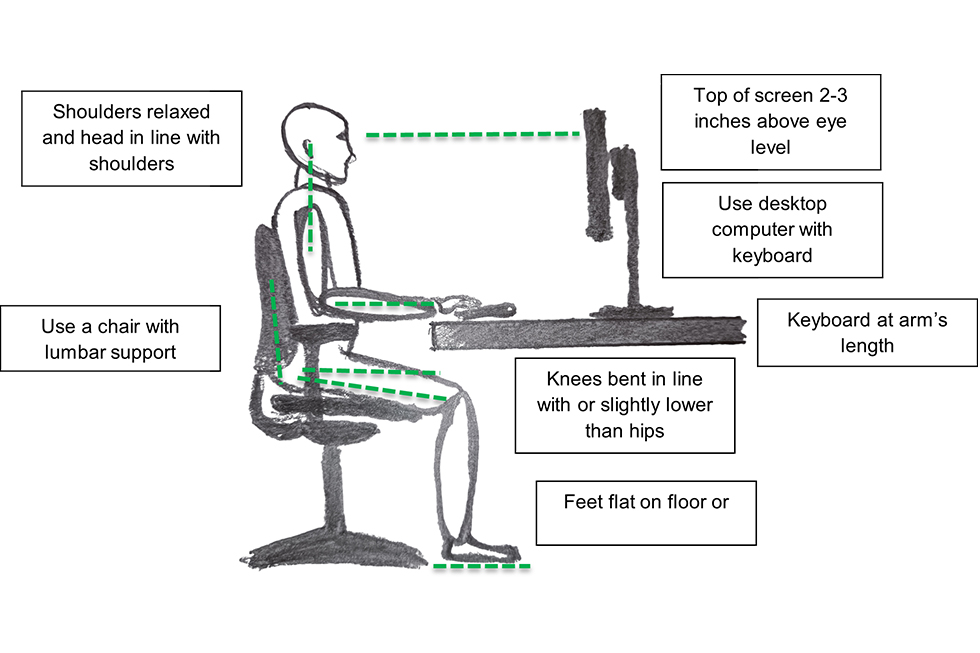A lot of desk-workers are familiar with an achy neck, sore shoulders, irritated eyes, headaches, wrist and elbow pains. However, a sedentary job does not only cause musculoskeletal aches and pains, it can also result in more serious health problems including chronic diseases and obesity, as well as affect mental health and cognitive functioning.(4)
Our bodies aren’t designed to sit rigidly for hours and hours. We need movement to keep our joints and bones healthy, circulate blood, digest our food, help our immune system, and for better concentration. (2)
An easy adaptation to make when working a desk job is to take regular activity breaks. You should move for 3 – 5 minutes, every 30 – 60 minutes e.g., get a glass of water, get something from the printer or do stretches at your desk. Secondly, a sit-stand desk is highly recommended as it allows you to break up your sedentary work time. In total, desk-based workers should accumulate 2 to 4 hours of standing and/or light activity work during working hours.(3)
Additionally, when seated for a certain period of time, it is important to have an ergonomic desk set-up:

To reduce strain on your eyes, apply the 20-20-20 rule, blink regularly and adjust the screen brightness. Every 20 minutes try to look away in the distance (20 feet) for at least 20 seconds.(1) A simple post-it note can remind you to blink every now and then, to avoid dry eyes, as we tend to blink less when staring at a screen. And lastly, adjusting the brightness of your screen according to the brightness of your surroundings can also ease the strain on your eyes.
When using the standing desk, ensure that you wear supportive and comfortable shoes and use an antifatigue mat. The anti-fatigue mat absorbs shock to protect your joints and its uneven surface encourages micromovements to maintain your balance which improves circulation, reduces muscle fatigue and improves body balance.(5)
And finally, guidelines suggest that an adult needs at least 150 minutes of moderate-intensity activity or 75 minutes of vigorous activity per week, ideally spread over 4-7 days. So take a little time for some exercise most days of the week.(6)
Are you struggling from the effects of a poor desk posture? We’re here to help…book in now so we can help get you feeling more comfortable at work!
References
1 Alghamdi,W.M. & Alrasheed, S.H., 2020. Impact of an educational intervention using the 20/20/20 rule on Computer Vision Syndrome. African vision and eye health, 79(1), pp. 177-182.
2 Baker, R., Coenen, P., Howie, E., Williason, A. & Straker, L., 2018. The short term musculoskeletal and cognitive effects of prolonged sitting during office computer work. International journal of environmental research and public health, 15(8).
3 Buckley, J.P., Hedge, A., Yates, T.Copeland, R.J., Loosemore, M., Hamer, M., et al., 2015. The sedentary office: an expert statement on the growing case for change towards better health and productivity. British journal of Sports Medicine, 49(21), pp. 1357-1362.
4 Carr, L.J. Leonhard, C., Tucker, S., Fethke, N., Benzo, R. & Gerr, F., 2016. Total worker health intervention increases activity of sedentary workers. American journal of preventive medicine, 50(1), pp. 9-17.
5 Taiar, R., Ahram, T.Z., Gardan, N., Schneider, A. & Sifaki-Pistolla, D., 2017. Impact of advance fabrics on human biomechanics: example of anti-fatigue mats. Advances in ergonomics modelling, usability & special populations, 486, pp; 301-313.
6 NHS, 2021. Physical activity guidelines for adults aged 19-64. Available at: https://www.nhs.uk/livewell/exercise/exercise-guidelines/physical-activity-guidelines-for-adults-aged-19-to-64/



